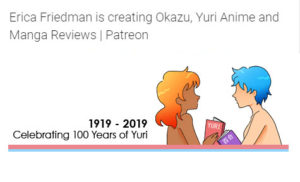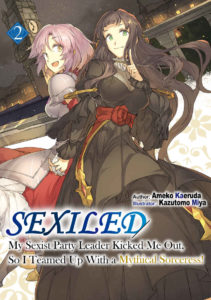As we wrap up this year, the 100th anniversary of the Yuri genre, I like to imagine what Yoshiya Nobuko might think, if she were to spring to life and see Yuri anime, manga, novels, games…stories of women in love with women, in both fantasy and “real world” settings and bookstores around the world with Yuri titles and manga stores with dedicated Yuribu. I’d like to think that once she got past the confusion of it all, she’d be pretty pleased about it. ^_^
For the 15th year in a row, I’m wrapping all the best Yuri people, companies, trends and titles up in one big old package and presenting it to you as the Okazu Top Yuri of 2019. ^_^ Please note there are no numbers, as this is not a countdown. Everything here is equally notable.
We’ll start with some well-deserved kudos to the pieces of the industry that set the places at which we sit and lay the feasts we enjoy.
 Yuri Publishers & Yuribu
Yuri Publishers & Yuribu
In this 100th anniversary of the genre, something almost miraculous occurred. Manga, anime and light novel publishers in the US and many of the major Japanese publishers are now investing in Yuri as Yuri.
My sincere thanks to everyone at Yen Press, VIZ Media, Seven Seas Entertainment, TOKYOPOP, J-Novel Club, UDON Entertainment, Kodansha Comics, Denpa, Lilyka Manga and in Japan, Ichijinsha, Futabasha, Shueisha, East Press, Seidosha, Hayakawa Shobo, Kadokawa Shoten, Akita Shoten and, at long last, Shogakukan.
Additionally, Japanese manga and bookstores have finally recognized that Yuri is a genre that does bring in business and have developed Yuri Clubs to help funnel money their way. ^_^ So thanks to Animate, Shosen, Gamers and Futabasha (again.) Toranoana has no Yuribu, but their Yuri Corner in the flagship store in Akihabara is worth noting, as well.
All these companies have recognized the potential of the growing LGBTQ and Yuri markets and responded to it with money and promotion (and in the case of US companies, care and attention,) which gives us hope for even more and even better Yuri in the year to come!
 Yuri Webcomics
Yuri Webcomics
Webcomics have been an important arm of indie comics since the early 2000s and the last few years has really seen the growth in online platforms for comic artists.
Pixiv has quite literally changed the game for indie artists in Japan like Nagata Kabi, and Webtoons and Lezhin have been among newer platforms that opened up a whole new audience to the joy of Yuri manga and comics.
Artists like Ratiana Satis (Pulse) and Kuru of Color_LES (Mage and Demon Queen) have changed the landscape for how – and where and by whom – people are able to find Yuri.
I think this kind of work is very exciting and very entertaining and always look forward to more new independent artists breaking out!
 Yuri Visual Novels/Games
Yuri Visual Novels/Games
I’m not going to lie, the visual novel landscape has a lot of problems, Steam’s inconsistent and obscure rule changes looming large among them. But the industry is full of energy and creativity that is worth talking about.
In 2019, Studio Élan created a whole new game engine for putting out innovative, unique, and original work. What I have seen has impressed me so very deeply. Indie creators gather annually for the Yuri Game Jam which gives space for smaller creative teams and individual devs to work on their idea and for you to try them out. Itch.io has quietly become a significant independent resource for game and VN developers and players.
Even if I will never be the audience for them, there are some really excellent VNs and games being made and I think they absolutely deserve a place on this list this year.
 Yuri Creators
Yuri Creators
There are so many creators of Yuri these days that it almost seems insulting to highlight a few names, but this year there has been some outstanding work by a few individuals, that I really believe it’s worth highlighting and celebrating them.
These are creators whose work has created change in the Yuri landscape: Yoshiya Nobuko (Yaneura no Nishojo) for setting in motion the creation of an entire genre by living her life and writing the stories she wrote; Riyoko Ikeda (Rose of Versailles), for having conversation about gender presentation and sexuality 40 years before anyone else had words for them; Takeuchi Naoko (Sailor Moon) who twenty-five years ago created characters so timeless, that we’re only now realizing just how important they are; Kabi Nagata (My Solo Exchange Diary), for her heart-breaking honesty – I know many of us want her to be healthy and happy; Takashima Hiromi (Kase-san and Yamada) for breaking Yuri romance out of high school where it had been locked for so long; Go Nagai (Devil Lady), for being a pioneer of queer women in his Devilman sagas; Takemiya Jin (Itoshi Koishi) for walking us along the path with a young woman who wants to be out and open with her friends; Ameco Kaeruda (Sexiled), for writing a feminist power fantasy that is empowering, delightful and funny; Morishima Akiko (Conditions of Paradise) who at long last in 2020 will get the English-language recognition as a Yuri manga artist that she deserves.
Breakthroughs often pass unnoticed until long afterwards. I will note that 2020 will mark the end of one the most important decades in history for our genre, as well as the end of the first century for the genre. Some of these names created a solid foundation for us to build upon and some are among the leading lights as we head into a new decade. They most assuredly deserve our thanks and a place on this list.
 Okazu Readers and Patrons
Okazu Readers and Patrons
You, my Okazu readers, are critically important to our mission here. It is a testament to your engagement that so many of you have become writers for Okazu and a testament to your personalities that so many of you have become my friends. ^_^ My very sincere thanks to every one of you who reads and comments on and shares our content.
My very special thanks to Okazu Patrons for making it possible for me to celebrate this year with reviews and lectures and panels and events. Your financial and social support helps us pay for guest writers and reviewers. Every year you make this list, and once again this year I can say with all honesty, I could not have done it without you.
 Light Novels & Novels
Light Novels & Novels
This year saw a veritable explosion of Light Novels and Novels in both digital and print. While as a genre LNs can be inconsistent, Yuri fans have been horribly spoiled by the high quality Light Novels we’ve seen.
J-Novel Club opened up their Yuri line with a salvo of truly excellent Yuri titles, including Last and First Idol,and Side-by-Side Dreamers. Seven Seas picked up what are extraordinarily good series-extension Bloom Into You, Regarding Saeki Sayaka. But the Light Novel that really blew my hair back was the totally-on-point brilliantly topical and deeply satisfying Sexiled series by Kaeruda Ameco. Those books scratched itches I didn’t know I had. If you haven’t read these, you should. Just go read them.
Will Yuri fans continue to be spoiled with top quality fantasy and science fiction Light Novels while everyone else has to deal with “the protagonist has no pants, hurh hurh” as a main plot point? I sure hope so. ^_^
Now as we enter the final few of of our end-of-year roundup, I want to take a moment to note a few series that just deserve a moment of reverence and thanks for all they’ve done and all they will continue to do.
 Our Dreams at Dusk Shimanami Tasogare
Our Dreams at Dusk Shimanami Tasogare
As I have repeatedly noted, this series is not Yuri. Instead, there is very real-world queer identity here; real problems faced by real people in the real world, which makes this series, if not unique, then at least extraordinary.
This story about self and community and creating a space in a world that isn’t welcoming…and then taking up that space and owning it, is a lot to ask of a work of fiction. Heck, it’s a lot to ask of life! Not only does Our Dreams at Dusk: Shimanami Tasogare succeed at that, it does it beautifully.
This is the kind of LGBTQ work I hope we’ll see more and more of from increasingly open queer manga artists.
 Sailor Moon Stars
Sailor Moon Stars
Every year I joke that if there is a Sailor Moon out that year, it will find a way on to this list. ^_^ Well this year a Sailor Moon that has never had an official English-language release is out and it so very, deeply, queer that it seems almost fantastic. Sailor Moon Stars is the final piece of the original series, and we’re looking forward to the Sailor Moon Crystal 4th season movies in the years to come.
Let me offer a toast to Sailor Moon Stars and to the permanent – and official – partnership of Tenoh Haruka and Kaioh Michiru – and welcome to the the next iteration of Sailor Moon fandom. Here’s to cafes and night drive parfaits and anniversary albums. May we all be together once again for the 50th anniversary.
 Rose of Versailles
Rose of Versailles
The wait has not been in vain. It *just* squeaked onto this year’s list by having a limited release in December. Don’t be surprised to see it back again in 2020. It’s almost 50 years old but we have an official English language release of The Rose of Versailles at last and it is a truly magnificent thing. UDON has really gone above and beyond for this release.
Oscar’s struggle with gender and class expectations, with the pressures of a society in which she may not be the person she wants to be, takes us through love and loss and the overturning of an ancien regime in a story that is terrifyingly timely.
This story of the French Revolution seen through the eyes of Oscar François de Jarjayes is so very, very extra.
A classic manga just in time for our 100th anniversary. What a year we’ve had. Our Yuri shelves are already full to bursting, with even more amazing stuff to come in 2020!
 Kase-san and Bloom Into You
Kase-san and Bloom Into You
Both the Kase-san series and Yagate Kimi ni Naru/Bloom Into You were relatively typical high school Yuri series. Both series managed to take the typical tropes of their origins and turn them into something interesting, unusual and ultimately, original. Both had animation that went above and beyond the manga and both had a global impact.
Once upon a time, all we wanted was a genuinely happy ending for a Yuri love story, an ending that showed our characters moving into the future together. This year, we got two. Moreover, neither series is riding its fame into the sunset, yet. Takashima-sensei’s Kase-san is ongoing and we’re getting some post-series work from Nakatani-sensei in anthologies and artbooks and I desperately hope to see signs of a third Sayaka novel soon.
These series have made it onto both of the other lists and it seems only reasonable to just say this plainly – both these series were tops for 2019.
I’ve mentioned this repeatedly during these lists (and have to tell you, we’re not done yet…) but this year was an amazing one, for me, for the Yuri genre, for all of us. Which brings me to the very best Yuri thing this year.
 100 Years of Yuri
100 Years of Yuri
Yuri Events were through the roof this year. It began with the an amazing time at TCAF and took me along, one fun Yuri-filled event to another. We did Yuri-focused Yurithon. We held the 100th Anniversary of Yuri Tour with a few like-minded friends, during which we spent time with the Sailor Senshi, and ate lunch with Fumi, flipped 500 yen coins at a shrine with Kuraku Asuka, bought Yuri goods and Yuri doujinshi and Yuri manga and glutted ourselves on food and threw money at Yuri artists at Girls Love Fest.
This celebration of Yuri’s 100th anniversary has been exhausting and amazing. I’ve met so many folks, got to meet new Yuri manga artists and see old friends and done so many presentations and had so very much fun.
The number one top Yuri thing of the year was…the year.
It’s been 100 Years since Yaneura no Nishojo (屋根裏の二) codified how we think and talk about Yuri. Thanks to Yoshiya Nobuko and thanks to all the people and companies on these lists. Thanks to all of you, my readers and commenters and my patrons.
Here’s looking forward to 2CYE (Common Yuri Era) in which the the fun is not over, as we extend the celebration into 2020 for the final 100th anniversary project here on Okazu. ^_^ Tune in tomorrow! And here’s to the next 100 Years!
![]() “…even though I was a kid, I didn’t want to feel like I was lagging behind. ”
“…even though I was a kid, I didn’t want to feel like I was lagging behind. ” 

